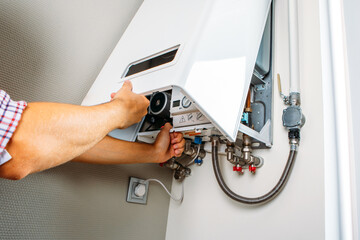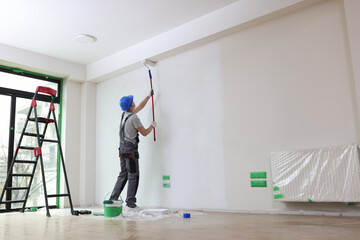Water heaters heat incoming cold water to supply sinks, dishwashers, clothes washers, and showers. Some also store hot water for use on demand.
Some homes have an existing electric connection to the water heater area; others might require a new circuit from the home’s power panel. If a new water heater is a gas, plumbers must make the gas connections. Contact Hot Water Now for professional help.
While installing a water heater may seem like a straightforward project for homeowners, there are important electrical aspects that must be taken into consideration. A faulty wiring connection can lead to a fire, so it is important to follow the instructions in your water heater’s wiring diagram carefully. The diagram can also help troubleshoot any issues you might run into during the process. If you encounter any problems, it is a good idea to consult a professional electrician or plumber.
First, you will need to disconnect the power supply to the water heater. This can be done by shutting off the breaker for the circuit that supplies power to the heater. You will also need to disconnect the gas line and drain valve from the heater. If you are using a gas water heater, it is recommended that you install a carbon monoxide detector in your home as well.
Next, you will need to drain the old water heater and clean out any sediment from the bottom of the tank. To do this, attach a garden hose to the drain valve and run it to a floor drain or outdoor location. Then, open the valve and drain the water. Then, you can begin working on the electrical connections.
Most electric water heaters require a 240-volt dedicated circuit with a 30-amp two-pole breaker. It is recommended that you use a metal-clad breaker. In addition, you will need a wire that connects the hot and cold water pipes to the water heater. This is known as a bonding jumper and is required by many building authorities.
In the case of a conventional storage-type electric water heater, it heats the water in the top portion of the tank first. This is because the upper element heats up faster than the lower element. Then, when the temperature setting is reached, the lower element takes over.
On the other hand, a tankless water heater heats the water on demand. It does this by capturing the heat from the air in your home. It uses about 60 percent less energy than a traditional electric water heater. However, it requires a gas or propane supply and is more expensive to operate than a standard electric model.
Plumbing
The plumbing aspect of water heater installation involves the connections to the home’s hot and cold water lines. This is a task that most plumbers perform, and it is usually straightforward. However, if you are replacing an old water heater, the plumbing work will be more involved, since you may have to reroute some of the plumbing to accommodate your new water heater. This could increase the installation costs.
If you are installing a gas water heater, the plumber will have to install a vent pipe and a gas line. They will also have to place the water heater in a pan that is designed to catch any leakage. This is required by code to prevent leaking water and steam that can damage the house and lead to mold, warped floors, and other problems.
For an electric water heater, the installer will have to connect the new water heater to the home’s electrical system. This will involve examining the wiring leading to the existing water heater and ensuring that there are no signs of damage or loose connections. The installer will then follow the manufacturer’s guidelines to connect the wires. This will usually include connecting the black wire from the water heater to the incoming power cable, and connecting the white incoming cable to the other water heater wire. The installer will also attach a bare copper or green grounding wire to the water heater’s green grounding screw.
After making sure that the electricity is turned off at the breaker box, the installer will remove the cover from the water heater’s junction box. Then, they will insert the conduit connector into the opening in the box and connect the wires to each other using wire nuts. The installer will then connect the bare copper or green grounding wire to a terminal on the water heater’s junction box.
Finally, the plumber will prepare new pipe assemblies for connection to the home’s cold water inlet and hot water outlet. They will usually be made of copper and will have galvanized nipples (smaller holes than regular pipe fittings). The plumber will wrap the nipples with tape and screw them into the cold water inlet and hot water outlet ports on the top of the new water heater. They will then solder in dielectric unions, which make it easy to disconnect the pipes in the future if necessary.
Safety
One of the most important things you can do to ensure a safe water heater installation is to make sure that all electrical wiring is done by a licensed electrician. This will not only prevent damage to the appliance itself but also ensure that the wiring complies with local codes and standards.
Another important safety step is to ensure that the pressure relief valve is properly installed and functioning. When this valve fails to open, it can cause a sudden, explosive release of pressurized hot water that could damage property and injure or kill family members.
Finally, be sure that a drain pan is connected to the water heater, and that it is inspected and replaced periodically to protect against water leaks. A drain pan is especially important for gas water heaters, as it helps to prevent the release of carbon monoxide into the home. In addition, a gas water heater’s flue (which is responsible for expelling combustion byproducts) must be properly ventilated to avoid carbon monoxide buildup.
Make sure that all gas connections are tight, and that the pilot light is lit only according to the manufacturer’s instructions. Be sure that the gas shut-off valve is closed before turning on the power to a gas water heater, and always check for a gas leak by sniffing near the appliance for a foul odor. If you smell gas, turn off the gas at the main valve and leave your house immediately! Contact your gas utility company and inform them of the problem right away.
Make sure that the hot water pipes are insulated, particularly if they will be located in a colder climate. This can help save energy and money while keeping the water warm longer. Finally, it’s important to familiarize yourself with the location of the water heater’s power and sewage shut-off valves, so that you can easily turn off these supplies in case of an emergency.
Inspection
Having a water heater professional inspect the water heater during installation not only helps ensure that all the facets of the system are properly installed and configured, but it also provides an opportunity for the plumber to perform preventative maintenance to keep your water heater in top shape. This can include cleaning the anode rod, flushing the tank to remove sediment and other debris, and examining and testing the thermostat and heating elements. For gas or propane-powered units the plumbing pro may also examine the gas line and venting system, as well as test the pressure relief valve, all of which help reduce energy costs, maximize lifespan of the unit, and prevent costly repairs.
In addition to the above items, a water heater inspection should include a check that all piping running to and from the heater are installed in accordance with the applicable codes and standards. This includes ensuring the piping is the appropriate size to avoid excessive water pressure, that all connections are tight and securely fastened, and that no water leaks can occur (especially around the fittings). The inspector should also note whether any galvanized piping was used, as these can leach lead into the domestic water supply.
Where water heaters are located in attics, the inspector should make sure the passageway into the attic is not obstructed and is sufficiently large to accommodate the largest component of the appliance (i.e., the water heater). The inspection should also note if the water heater is adequately insulated.
The inspection should include a check that the manufacturer’s installation, operating and maintenance instructions are left at or near the water heater, or are otherwise made readily available to the Authority Having Jurisdiction, service personnel and building occupants. The inspector should also note the existence of a thermal expansion tank, which is required to prevent over pressurization of the water heater system, as well as verify the installation and size of the tank to prevent explosion and damage. Finally, the inspector should check that there is adequate combustion air opening to the water heater in accordance with the fuel gas code.





